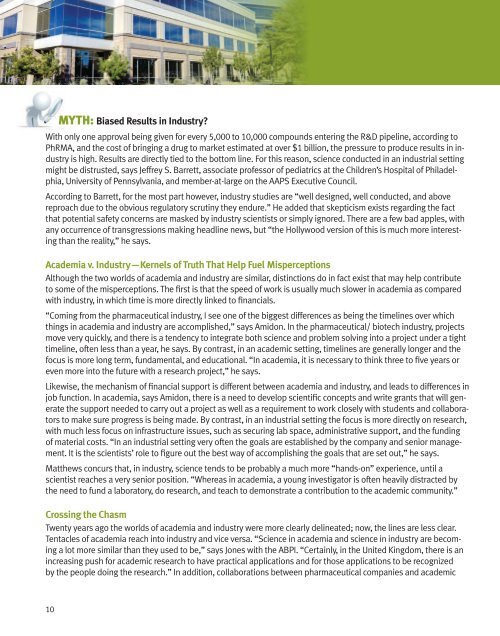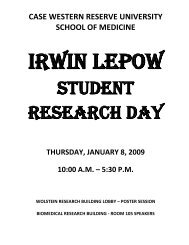Science Careers 2012 Career Directory - Case Western Reserve ...
Science Careers 2012 Career Directory - Case Western Reserve ...
Science Careers 2012 Career Directory - Case Western Reserve ...
You also want an ePaper? Increase the reach of your titles
YUMPU automatically turns print PDFs into web optimized ePapers that Google loves.
MYTH: Biased Results in Industry?<br />
With only one approval being given for every 5,000 to 10,000 compounds entering the R&D pipeline, according to<br />
PhRMA, and the cost of bringing a drug to market estimated at over $1 billion, the pressure to produce results in industry<br />
is high. Results are directly tied to the bottom line. For this reason, science conducted in an industrial setting<br />
might be distrusted, says Jeffrey S. Barrett, associate professor of pediatrics at the Children’s Hospital of Philadelphia,<br />
University of Pennsylvania, and member-at-large on the AAPS Executive Council.<br />
According to Barrett, for the most part however, industry studies are “well designed, well conducted, and above<br />
reproach due to the obvious regulatory scrutiny they endure.” He added that skepticism exists regarding the fact<br />
that potential safety concerns are masked by industry scientists or simply ignored. There are a few bad apples, with<br />
any occurrence of transgressions making headline news, but “the Hollywood version of this is much more interesting<br />
than the reality,” he says.<br />
Academia v. Industry—Kernels of Truth That Help Fuel Misperceptions<br />
Although the two worlds of academia and industry are similar, distinctions do in fact exist that may help contribute<br />
to some of the misperceptions. The fi rst is that the speed of work is usually much slower in academia as compared<br />
with industry, in which time is more directly linked to fi nancials.<br />
“Coming from the pharmaceutical industry, I see one of the biggest differences as being the timelines over which<br />
things in academia and industry are accomplished,” says Amidon. In the pharmaceutical/ biotech industry, projects<br />
move very quickly, and there is a tendency to integrate both science and problem solving into a project under a tight<br />
timeline, often less than a year, he says. By contrast, in an academic setting, timelines are generally longer and the<br />
focus is more long term, fundamental, and educational. “In academia, it is necessary to think three to fi ve years or<br />
even more into the future with a research project,” he says.<br />
Likewise, the mechanism of fi nancial support is different between academia and industry, and leads to differences in<br />
job function. In academia, says Amidon, there is a need to develop scientifi c concepts and write grants that will generate<br />
the support needed to carry out a project as well as a requirement to work closely with students and collaborators<br />
to make sure progress is being made. By contrast, in an industrial setting the focus is more directly on research,<br />
with much less focus on infrastructure issues, such as securing lab space, administrative support, and the funding<br />
of material costs. “In an industrial setting very often the goals are established by the company and senior management.<br />
It is the scientists’ role to fi gure out the best way of accomplishing the goals that are set out,” he says.<br />
Matthews concurs that, in industry, science tends to be probably a much more “hands-on” experience, until a<br />
scientist reaches a very senior position. “Whereas in academia, a young investigator is often heavily distracted by<br />
the need to fund a laboratory, do research, and teach to demonstrate a contribution to the academic community.”<br />
Crossing the Chasm<br />
Twenty years ago the worlds of academia and industry were more clearly delineated; now, the lines are less clear.<br />
Tentacles of academia reach into industry and vice versa. “<strong>Science</strong> in academia and science in industry are becoming<br />
a lot more similar than they used to be,” says Jones with the ABPI. “Certainly, in the United Kingdom, there is an<br />
increasing push for academic research to have practical applications and for those applications to be recognized<br />
by the people doing the research.” In addition, collaborations between pharmaceutical companies and academic<br />
10<br />
institutions are becoming much more common, with pharmaceutical companies supporting Ph.D. studentships and<br />
providing placements for students in commercial laboratories.<br />
Barrett agrees that a growing number of industry-based postdocs and internships are now extended to students.<br />
“As someone who trains and supports research in these disciplines, I have witnessed both the support from industry<br />
in the form of funding for postdoc training as well as the competition for students/trainees.”<br />
Industry funding of universities for various studies has also increased. Academia is simultaneously expanding its relationships<br />
with industry with more “biofeeders,” and commercial enterprises springing from academic endeavors,<br />
which did not occur so much 20 years ago, Delong says.<br />
In general, starting salaries are similar between industry and academia, although in academia, early postdocs trying<br />
to prove themselves can potentially put in many more hours than an industry scientist. “Academics put in long hours<br />
competing for grants, and it’s a very tough lifestyle,” says Delong. “Postdocs who have gone into industry typically<br />
put in more than a 40-hour workweek, but they are not always struggling for the next grant or trying to prove themselves<br />
in the same way,” she says.<br />
Klee points out that he actually made more money when he returned to academia from industry, but the pay scales<br />
for a starting scientist and a starting assistant professor are similar. “I think it’s more the attraction of industry that<br />
students feel,” he says. “I’ve heard comments like, ‘I can write a great grant proposal, and it doesn’t get funded.’<br />
What that means is that there is a perception that you can be really good and not make it in academia through no<br />
fault of your own, and I think that’s probably true.”<br />
Principal Industry Facts<br />
• The biosciences industry sector is defi ned as including the following four subsectors.<br />
Agricultural Feedstock and Chemicals<br />
Drugs and Pharmaceuticals<br />
Medical Devices and Equipment<br />
Research, Testing, and Medical Laboratories<br />
• As of December 31, 2006 (the latest time point for which information is available), there<br />
were 1,452 biotechnology companies in the United States, of which 336 were publicly held.<br />
• There were 180,000 employed in U.S. biotech companies in 2006.<br />
• The average annual wage of U.S. bioscience workers was $71,000 in 2006, more than<br />
$29,000 greater than the average private-sector annual wage.<br />
Biotechnology industry facts are available at<br />
http://bio.org/local/battelle2008/State_Bioscience_Initiatives_2008.pdf<br />
11

















